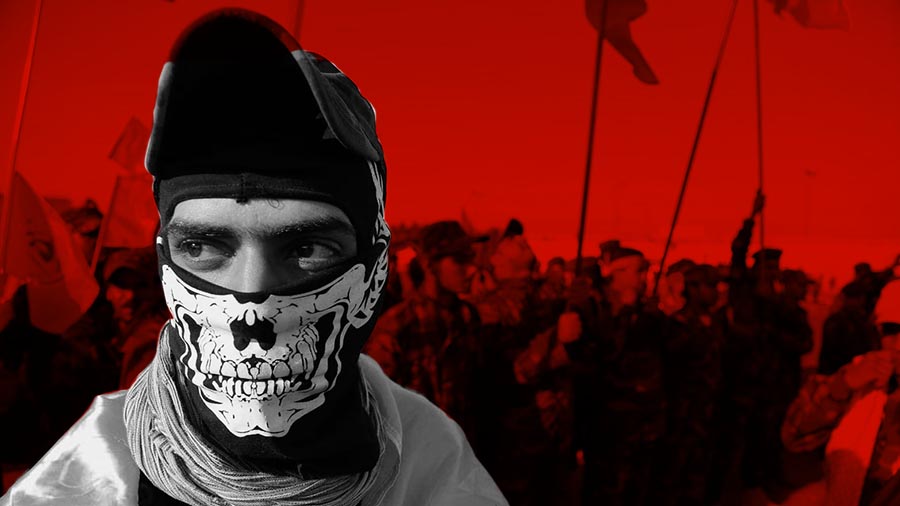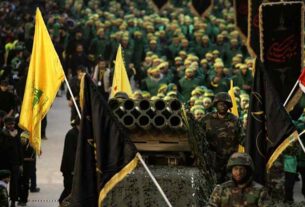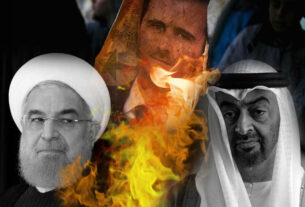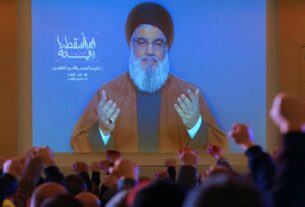Sun 29 March 2020:
And how it will be undone.
In December 2002, a group of 350 Iraqi opposition politicians gathered for a conference titled “To Save Iraq and Achieve Democracy” in the Hilton Metropole Hotel on Edgware Road in London. Many of the attendees were Iraqi politicians who had lived in exile for most of their adult lives and who had spent much of that time supporting the plans of the United States for imperialist intervention in the country.
It was during this conference, and under pressure from the US ambassador to Iraq, Zalmay Khalilzad, that Iraq’s political future was decided and the muhasasa ta’ifia, the ethno-sectarian apportionment system that was imposed on Iraqis following the invasion, was decided on.
Jalal al-Talabani, then leader of the Patriotic Union of Kurdistan (PUK) who would later become president of Iraq, defined the mission of the conference as “restoring unity to Iraq as a people, territory and entity”. Masoud Barzani, the leader of the Kurdistan Democratic Party (KDP), who in 2005 would become president of the newly established Kurdistan Region of Iraq, emphasised the need for “a spirit of reconciliation and preservation of the [national] interest”. Ahmed al-Chalabi, who would later head the oil ministry, called for “a new way of thinking and the consolidation of democratic principles”.
At the closing of the conference, the opposition published a 10-page political statement, which emphasised their desire to root out sectarianism, which was defined in terms of Saddam Hussein’s persecution of the Shia community, and to build a new Iraq based on human rights and equality for all its citizens.
Today, more than 17 years later, it is quite clear that many of these pronouncements were no more than empty rhetoric. At the moment, Iraq is neck-deep in sectarian politics, which has led to an unprecedented political crisis and increasing failure of the state to provide for the basic needs of its citizens.
The origins of the muhasasa
The Iraqi opposition and its Western allies first came up with the idea of the muhasasa, which distributes political power and state resources between three main religious and ethnic groups – Shia, Sunni and Kurds – during a series of conferences that took place throughout the 1990s.
The first of these gatherings was held in the Salah al-Din resort in the Kurdish-controlled region of northern Iraq in October 1992. There, a number of governing bodies were created with the idea that they would come to power when Saddam Hussein was overthrown.
Positions on these bodies were allocated on the basis of the conference’s perception of the percentage of Iraqis who were Shia, Sunni and Kurdish, therefore laying the groundwork for the muhasasa.
Attendees presented this new political system as a means of uniting Iraqis and presenting a democratic alternative to Hussein’s dictatorship. During its opening session, Barzani announced that the future of Iraq was in the hands of those present, declaring “we can save Iraq from dictatorship … we must save the Iraqi people … we must overthrow Saddam Hussein”. He later went on to describe the gathering as “a victory for all Iraqis”.
Shia leader Mohammed Baqir al-Nassari said the attendees wanted Iraqis to be free and “to be able to express their opinions toward the government as they want, regardless of whether the leader is Sunni or Shia or Kurdish”.
The influence of the US and its allies on the rhetoric adopted during these conferences was quite clear from the way the opposition instrumentalised the language of unity and human rights, as well as imperialist calls to “save the Iraqi people”.
John Major, British prime minister between 1990 and 1997, used this same language when he stated, “a united opposition is the only one that can provide a real alternative to Saddam Hussein”, referring to the opposition which came together at the Salah al-Din conference. Later on, in the run-up to the invasion of Iraq, George W Bush would repeatedly affirm Washington’s commitment to universal rights, claim that all people “are entitled to hope and human rights” and make promises that the war would allow Iraqis to live in dignity.
Contrary to claims of democratisation and reconciliation, however, what the opposition was in fact doing was dividing Iraq along ethno-sectarian lines, as if this were the central and only organising factor of Iraqi society.
This was already apparent during the 1992 conference when, for example, a representative of the Iran-backed party the Supreme Council for Islamic Revolution in Iraq, declared “we do not want another Iraq where the minority rules”.
The divisiveness of the ethno-sectarian apportionment system did not go unnoticed by critics of the 2002 conference. The Iraqi Liberal Democratic Party, which boycotted the gathering, for example, announced that they stood “against all attempts to spread sectarianism on a proportional basis” and stressed that they had repeatedly “warned the conference in London against building on the suggestions of the Salah Al Din conference”.
Similarly, Ihsan Abdelwazir, a spokesman for the Islamic Movement, a group of Kurdish and Arab Sunni Muslims based in northern Iraq, predicted that the decisions made at the conference would “bring city-to-city fighting to Iraq”.
A dysfunctional system
When the opposition was eventually put in power by the US-led coalition following the invasion of Iraq, much of what critics of the muhasasa had predicted came to pass.
The system was largely responsible for fuelling the post-invasion civil war, when the very same politicians who had made endless speeches about reconciliation, unity and democracy, used violence to protect and increase their stake in a political system that was imposed without any consultation with common Iraqis.
What is more, the muhasasa has encouraged rampant corruption. Ministerial portfolios, civil service jobs and government contracts have been distributed along ethno-sectarian party lines. Since 2003, successive Iraqi governments have been paralysed due to the clash of sectarian and partisan interests. There has also been massive institutional dysfunction.
As a result, the Iraqi state which would receive $6bn per month in oil revenue has not been able to provide its citizens with even the most basic public services.
It has not taken long for common Iraqis to see the dysfunction of the muhasasa system. In fact, in response to its many ills, a mass protest movement emerged in central and southern Iraq in October last year. Protesters have openly criticised the system and its failures and have called for systemic political change.
At their demonstrations, they would often chant “no to muhasasa, no to political sectarianism”, draw anti-muhasasa graffiti and put up satirical banners mocking the superficial claims that the current political system includes all segments of Iraqi society.
Despite the reassurances about freedom of speech and human rights which the architects of the muhasasa gave prior to the US invasion, the violent crackdown on the protests has once again demonstrated that those were just empty words.
The killing of almost 700 demonstrators and injuring of 30,000 others in just six months laid bare the moral bankruptcy of those politicians who masterminded and implemented the muhasasa and their determination to preserve the political system at any cost.
The mass protests have challenged the rhetoric that enabled the imposition of the muhasasa, allowing Iraqis to imagine a new Iraq for the first time. Ultimately, the solution to the Iraqi crisis will not come from those who designed the current political system, but from below, from the Iraqi people.
ABOUT THE AUTHOR
The statements, views and opinions expressed in this column are solely those of the author and do not necessarily represent those of Independent Press.






